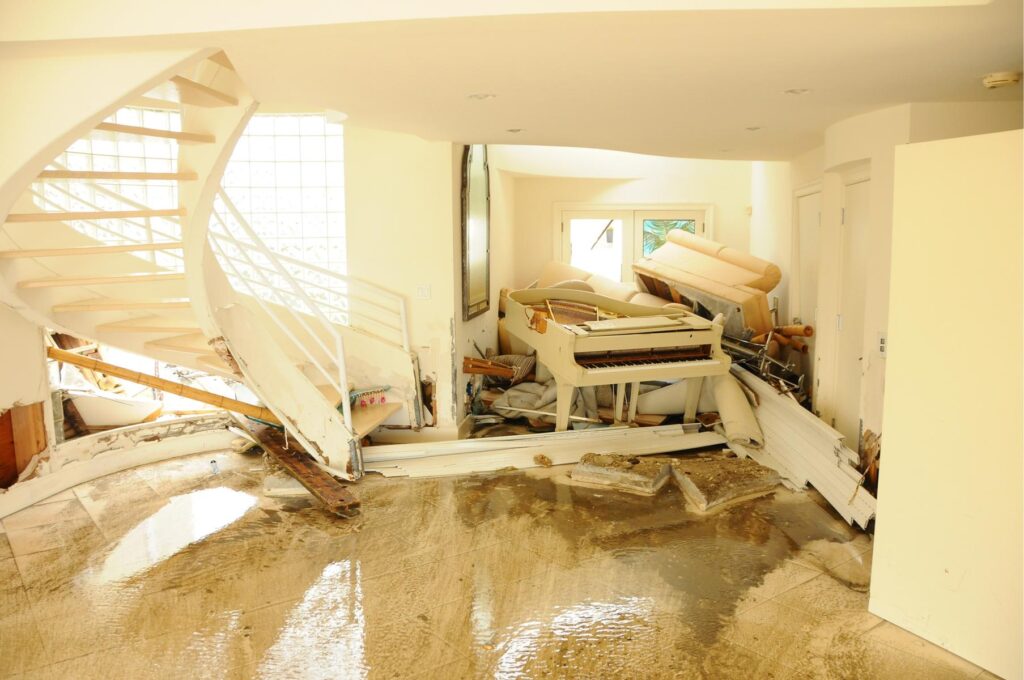
Contents
When faced with flood damage, knowing how to act quickly can make all the difference. You’ll need to assess the damage first, prioritizing areas that require immediate attention. Having the right tools on hand can speed up recovery greatly. But it’s not just about equipment; safety must always come first. Understanding the full scope of what’s involved sets the stage for effective recovery. Let’s explore the key steps to ensure you’re prepared for the challenges ahead.
Key Takeaways
- Conduct a thorough damage assessment immediately to prioritize structural integrity and health risks.
- Utilize high-capacity water pumps and wet/dry vacuums for effective water extraction.
- Implement moisture mapping and high-velocity air movers to accelerate drying processes.
- Wear proper safety gear and turn off the electricity to mitigate repair hazards.
- Collaborate with professionals for expert guidance and efficient restoration throughout the recovery process.
Assessing the Damage and Prioritizing Areas for Immediate Action
When you’re faced with the aftermath of a flood, taking a moment to assess the damage can make all the difference. Start with a thorough damage evaluation, walking through each affected area. Document what you see—water levels, structural issues, and ruined belongings. This initial assessment helps you understand the extent of the damage and can guide your recovery timeline.
Prioritize areas that need immediate action. Focus on structural integrity first; if walls or foundations are compromised, they require urgent attention.
Next, consider health risks—remove any contaminated materials to safeguard your family.
Don’t hesitate to reach out for help—community resources and support networks can be invaluable during this time. Remember, you’re not alone in this process.
Essential Equipment for Effective Water Extraction
After evaluating the damage and identifying areas that need immediate attention, the next step is to gather the right equipment for effective water extraction. Having the right tools can make a significant difference in your recovery efforts. Here’s a quick guide to essential equipment:
| Equipment Type | Purpose | Recommended Features |
|---|---|---|
| Water Pumps | Remove standing water | High capacity, portable |
| Extraction Tools | Pull moisture from surfaces | Lightweight, ergonomic design |
| Wet/Dry Vacuums | Clean up smaller debris and water | Strong suction, multiple attachments |
| Sump Pumps | Prevent future flooding | Automatic activation |
| Dehumidifiers | Reduce humidity post-extraction | Energy efficient, large tank |
Techniques for Rapid Structural Drying
While water extraction is crucial, rapid structural drying is equally essential to prevent long-term damage and mold growth. You’ll want to start by utilizing moisture mapping, which helps you identify areas with hidden moisture. This technique allows you to focus your drying efforts where they’re needed most.
Once you’ve pinpointed these areas, employ effective drying techniques. High-velocity air movers can greatly speed up the evaporation process, while dehumidifiers remove excess moisture from the air. You might also consider thermal imaging cameras to ensure no damp spots are left behind.
Remember to monitor the drying progress regularly; this helps you gauge effectiveness and fosters a sense of control during a chaotic time.
Safety Precautions During Flood Damage Repair
Before diving into flood damage repair, it’s crucial to prioritize safety to protect yourself and your loved ones.
Start by donning appropriate safety gear, including gloves and boots, to shield against contaminants and sharp objects. Confirm you wear a mask if mold is present; your health is paramount.
Next, be aware of potential electrical hazards. Turn off the electricity in affected areas before starting any repairs. Use a moisture meter to assess the environment; if it’s too wet, wait for conditions to improve.
Always assume that submerged outlets or appliances are live, and avoid using them until a professional clears them.
Lastly, keep a first-aid kit handy and have emergency contacts on speed dial.
Working With Professionals for Comprehensive Recovery
When it comes to flood damage recovery, enlisting professionals can make a significant difference in the outcome. They bring expertise and resources that can ease your burden during this challenging time.
Here’s how working with professionals can help:
Expert consultations: They assess the damage thoroughly, ensuring you understand what needs to be done.
Efficient restoration: Professionals have the equipment and experience to restore your home quickly and safely.
Navigating insurance claims: They can guide you through the often-confusing claims process, maximizing your benefits.
You don’t have to face this journey alone. Collaborating with specialists will ensure a thorough recovery and ensure that you feel supported every step of the way.
Their knowledge and empathy can transform an intimidating situation into a manageable process, helping you regain a sense of normalcy sooner. Trust in their expertise to bring your home back to life.
Review
In the aftermath of a flood, swift and strategic recovery is key. By evaluating damage diligently and using essential equipment, you can tackle this tough situation head-on. Remember, prioritizing safety and seeking professional support fosters a formidable foundation for rebuilding. Embrace community connections to bolster your resilience and restore hope. With determination and the right resources, you’ll transform turmoil into triumph, paving the way for a brighter, drier future.
Recent Posts
Three Steps for Fast Flood Damage Recovery
When faced with flood damage, it’s essential to act swiftly and methodically. You need to
Quick Flood Damage Repair: Essential Steps
When faced with flood damage, your first priority should be safety. Assess the situation quickly,
What Are Quick Techniques for Flood Damage Repair?
When facing flood damage, it’s vital to assess the extent of the situation quickly and
